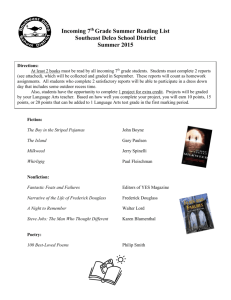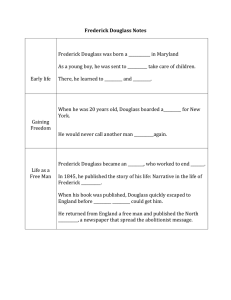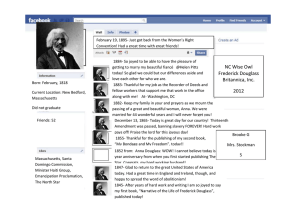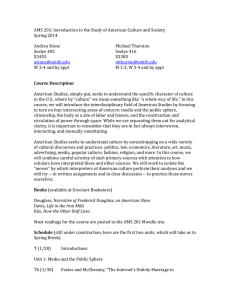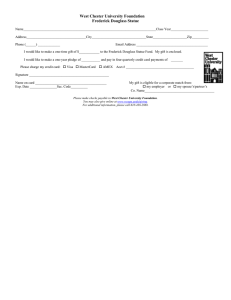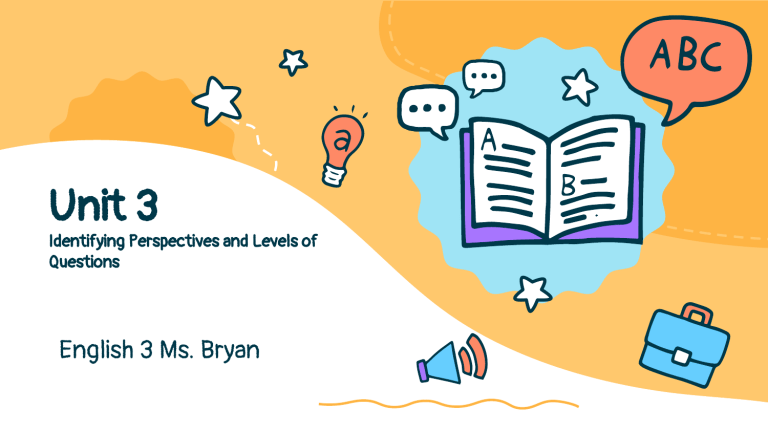
Unit 3 Identifying Perspectives and Levels of Questions English 3 Ms. Bryan Last class: - Bellringer Civil War: Interpreting and Analyzing Perspectives Crash Course Civil War Video, Civil War Article Today’s objective (11/7): -Students will summarize key details from literary sources related to the same topic. -Students will revisit literary sources to infer authorial intent regarding bias and perspective. Essential Questions: How do literary perspectives impact the cultural narrative of historical events? Relevant standards: Inquiry 3.2 Examine historical, social, cultural, or political context to broaden inquiry and create questions. Inquiry 3.4 Organize and categorize important information; synthesize relevant ideas to build a deeper understanding; communicate new learning; and identify implications for future inquiry. Monday Bell Ringer Watch the video and Summarize the Bio of Frederick Douglass. Literary Analysis: Formulating Understanding from Text and Other Media. Phases of analyzing literary resources: Summarize Comprehend Infer Meaning Identify the Key Details Revisit resources to identify details which build comprehension Use prior understandings to make inferences within the text/ resource Expand Understanding Connect elements of the resource to external topics and themes. Review: What are the Key Elements of Summaries? Condense the original text (shorten!) Includes only the most important information from the original text. Includes only what is in the original passage (no external knowledge). Written in your own words: ○ Paraphrasing ○ Restating AVOID: ● First person narration ● Dialogue ● BEGINNING THE PASSAGE WITH: “This text is about..” OR “What the writer said was…” ● ● ● ● Think Why is it important to summarize a text? ● Summarizing texts or informational resources improves our understanding of the information and helps us to memorize the content Steps to Summarizing (texts) 1. Scan Scan the text to get an idea of topic and it’s length 3. Define When reading, underline unknown words. Define words if their meaning is unclear from context. 2. Read Read the text carefully, highlight important points and annotate your ideas 4. Skim Scan over the text again to confirm you’ve understood key points. Summarizing Audio/Video Resources ● Read the “abstract” of the video or audio if available. ● Assess the length and consider breaking up the resource into “summary sections”. ● While watching or listening, pause frequently to identify the key concepts of the resource. ● Repeatedly rewind and rewatch to ensure complete understanding. Abstract DO NOW Re-read your summaries of each source and check that you have included all pertinent details. (5+ sentences) Crash Course: The Civil War Part 1 (We did this together, but check your writing anyway). Next: Check your Summaries Re-read your summaries of each source and check that you have included all pertinent details. (5+ sentences) How the North Distorts Civil War History CREDITS: This presentation template was created by Slidesgo, including icons by Flaticon, and infographics & images by Freepik. Comprehend Write in your notes, then share From the Article: From the Video: What is the main idea of the article regarding the Civil War? What is the main idea of the video regarding the Civil War? Synthesize Information ● Use only information from the resources (both notes and summaries).... Analyze how each perspective narrates the impact of the Civil War. Compare and contrast the narratives through an objective summary/ lens. Tuesday Bell Ringer Infer How does information Last class: - Today’s objective (11/8): Bellringer Summarizing Resources Completion of “Civil War: Analyzing and identifying Perspectives” The Lost Cause Essential Questions: How do literary perspectives impact the cultural narrative of historical events? Relevant standards: Inquiry 3.2 Examine historical, social, cultural, or political context to broaden inquiry and create questions. Inquiry 3.4 Organize and categorize important information; synthesize relevant ideas to build a deeper understanding; communicate new learning; and identify implications for future inquiry. Levels of Questions Learning how to ask your own questions while analyzing literature leads to deeper understanding as well as a deeper understanding of the world around you. Level Three Reading on the line. Level Two Reading between the lines. Level One Reading beyond the lines. Levels of Questioning I like to give each level of questioning a special name to help us remember how to identify and create questions at each level. 1. Reading on the line 2. Reading between the lines 3. Reading beyond the lines Level 1: Reading on the Line Reading on the line means reading and understanding what a text says directly. This level of reading involves knowing and understanding the key ideas and details in a text. (Who?, What?, When?, and Where? questions are typically level 1 questions.) When answering a level 1 question, you can literally put your finger on the correct answer in the text. LEVEL 1 Your task: In your Canva notes, answer the first two questions Level 2: Reading between the Lines Readingbetween Reading betweenthe the lines lines requires requires a reader a reader to interpret/infer to something from something interpret/infer what the textfrom sayswhat explicitly. the text says explicitly. This level This levelofofreading reading requires requires actual actual analysis. analysis. (What (What do the dowords the in the text words in the suggest?) text suggest?) Whenanswering When answeringa alevel level 2 questions, 2 questions, youyou can’t can’t point point to the to exact the answeranswer exact in the text, in the buttext, you but can point you can to the point words to the youwords use to you maketoan use make inference. an inference. An example of a “between the lines” or level 2 question from The Crucible What might be an example of a “shred of goodness” from Proctor’s point of view? Again, I can look to the text for evidence, but this time, I will most likely find indirect answers. John Proctor: “...You have made your magic now, for now I do think I see some shred of goodness in John Proctor. Not enough to weave a banner with, but white enough to keep it from such dogs.” LEVEL 2 Your task: Answer the third question on your Canva notes about level-2 questions What might you predict about level 3 questions? Level 3: Reading beyond the lines Reading beyond the lines requires a reader to move beyond the text to connect to another text or a larger meaning. Readers at this level move from the “What?” to “So what?” (How does this text connect to other texts, life, morality, values, etc.?) An example of a “beyond the lines” or level 3 question From The Crucible Identify a female archetype in The Crucible. What does this character suggest about the roles of women in American puritanical society? This question is about the text but also about gender roles and women’s experiences in American society. Grading and Level 3 Questions The answers to level 3 questions could vary greatly. (So how is an answer to a question like this graded?) LEVEL 3 Your task: In your Canva notes, answer the last question about level-3 questions It’s all about how you support your answer! You need effective evidence and explanation. RECAP Reading on the line Reading beyond the line Random student #1 Random student #3 Reading between the lines Random student #2 Importance of asking good questions Random student #4 Goodbye, see u 2morrow Exit Ticket:Weds, Oct 27 1. What could you do to study for tomorrow’s grammar quiz over commas? 2. Which type of score will the quiz be: classwork, formative, or summative? 3. What could you infer from this slide? Bell work: Weds, Oct. 27 1. Who are these people? 2. What do they have in common? Today’s agenda: 1 2 3 Grammar Quiz 5 kinds of Commas Group Reading Read together Ch 1 of The Narrative of the Life of Frederick Douglass Independent Reading Exit ticket related to preface Exit Ticket (10/27) 1. How could you summarize this preface? 2. Without knowing who specifically Wendell Phillips is, why could you infer that his endorsement of F.D.’s narrative significant? Explain please. Canva Bellwork: Thursday (10/28) On the internet, open up the text we read yesterday from gutenberg.org (Google “Frederick Douglass gutenberg” to quickly access it). Write an example of a level 1 question AND a level 2 question based on Chapter 1. Please indicate which is which. What is the significance of the prefaces of F.D.’s narrative? Let’s pick up at Ch. 2. We will complete a brief chart activity before reading chapter 3. Frederick Douglass in Ch 2 What does he say? What does he do? Random student #1 Random student 2 What does he think? What does he feel? Random student #3 Random student #4 The answers on your squares probably paint a sad, discouraged portrait of Frederick Douglass. Do you think Douglass wants people to feel sympathy for him? (Random student #5 will answer) Goodbye, see u 2morrow Exit Ticket:Thurs, Oct 28 Reread the last paragraph of Ch 3. When you think about the experiences and lack of opportunities given to slaves, what are some reasons why the slaves would bicker or boast about who is the ‘best’ slaveholder? Bellwork Friday 10/29 Write some questions Look back over chapters 1 & 2 of The Narrative of the Life of Frederick Douglass. Please write 2-3 discussion questions over the chapters that could categorize as either level 2 or level 3. Refer back to your levels of questions notes! Exit Ticket: Friday, Oct 29th Chapters 4-6 What was the pathway from slavery to freedom, as discovered by Frederick Douglass in this section. Explain. Monday, Nov 1st Bell Work NOTE: Bellwork and exit tickets have moved from Canva.com to Google Docs. Please go to Canvas Assignments or Modules and open - “Bellwork/Exit Tickets Nov 1-5” Bell work question: How are connotations and pathos (emotional component of arguments) related? Last class: -Ch 4-6 of Frederick Douglass’ narrative - Discussion questions with groups Today’s objective (11/01): Students will continue reading The Narrative of the Life of Frederick Douglass and begin posing questions Relevant standards: Determine an author’s point of view or purpose Delineate and evaluate the reasoning in seminal U.S. texts VOCAB WORDS (instruction and practice through vocabulary.com) Heinous (adj) Definition: Very wicked, offensive, hateful. Insurgent (noun or adj) Vicarious (adj) (noun) One who rebels or rises against authority. (adj.) Rising in revolt, refusing to accept authority Immutable (adj) Not subject to change, constant Performed, suffered, or otherwise experienced by one person in place of another. Transgress (verb) (v.) To go beyond a limit or boundary; to sin, violate a law. Chapter 7 Audiobook Version We will have a pair-share conversation after we read Discussion Questions over Ch 7 #1 #2 Read the quote from the text below. How would you describe Douglass’ tone as a writer here. Why do you think he uses this tone? Read the quote from the text below. Discuss how this statement is true. “I often found myself regretting my own existence, and wishing myself dead; and but for the hope of being free, I have no doubt but that I should have killed myself, or done something for which I should have been killed. While in this state of mind, I was eager to hear any one speak of slavery.” “education and slavery were incompatible with each other” Chapter 8-9 Please read independently! Exit Ticket Monday, Nov. 1 Announcement: You will have a reading quiz over Ch 7-9 on Weds! Use 3 of your vocab words to write a general summary of Frederick Douglass’ life.
